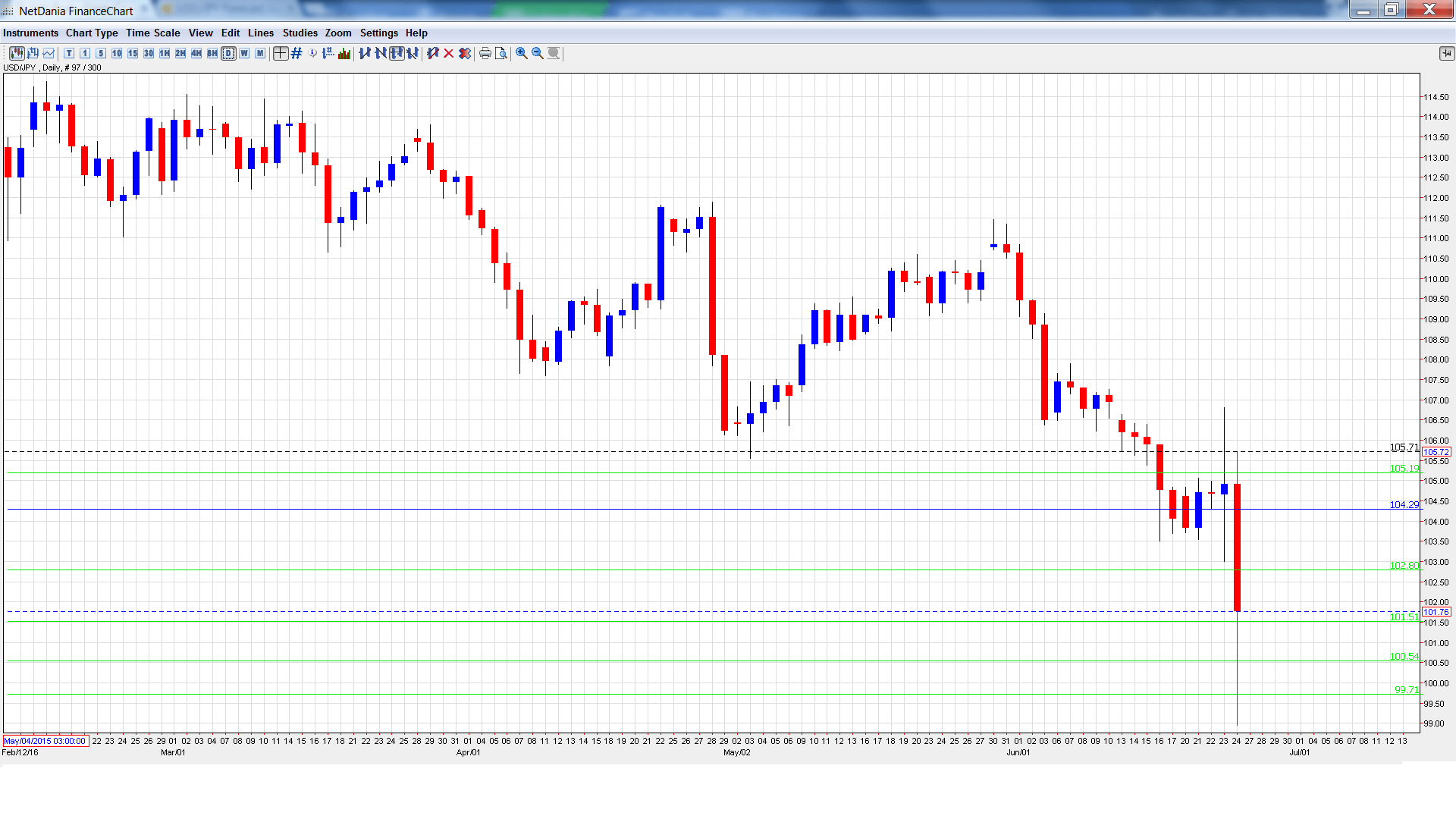USD/JPY dropped almost 300 points last week, and briefly dropped below the symbolic 100 level. The pair closed the week at 101.76. This week has 9 events. Here is an outlook on the major events moving the yen and an updated technical analysis for USD/JPY.
In a vote that has sent shock waves in the UK and across Europe, Brits decided to leave the EU in a decisive 52% to 48% vote. After the vote, the safe-haven yen posted strong gains as investors shied away from risk. The Brexit has implications not only on the economies of Europe, but across the globe. In the US, Yellen sounded quite dovish and a rate hike is unlikely before September at the earliest.
do action=”autoupdate” tag=”USDJPYUpdate”/]
USD/JPY graph with support and resistance lines on it. Click to enlarge:
- Retail Sales: Tuesday, 23:50. Retail Sales is the primary gauge of consumer spending. The indicator continues to point to weak consumer spending, with only one gain in 2016. The indicator declined 0.8% in April, and the markets are expecting a sharper decline in May, with an estimate of -1.6%.
- Preliminary Industrial Production: Wednesday, 23:50. This manufacturing indicator posted a small gain of 0.3% in April, well above the forecast of -1.4%. The forecast for the May report is -0.1%.
- Housing Starts: Thursday, 5:00. This indicator provides a snapshot of the level of activity in the housing sector. The indicator posted a strong gain of 9.0% in April, well above the estimate of 3.9%. The estimate for the May report stands at 4.9%.
- Household Spending: Thursday, 23:30. Household Spending is an important consumer spending. The indicator has struggled, with just one gain in 2016. Another decline is expected in the May release, with an estimate of -0.9%.
- Tokyo Core CPI: Thursday, 23:50. This index is the most important inflation indicator and should be treated as a market-changer. The indicator has failed to post a gain in 2016, as Japanese inflation levels remain low. The May reading came in at -0.5% and an identical reading is expected in the upcoming release.
- Tankan Manufacturing Index: Thursday, 23:50. The indicator dropped to 6 points in Q1, shy of the estimate of 8 points. The downward trend is expected to continue, with an estimate of 4 points for Q2.
- Tankan Non-Manufacturing Index: Thursday, 23:50. The indicator dipped to 22 points in Q1, short of the forecast of 24 points. The markets are expecting a weaker reading in Q2, with the estimate standing at 19 points.
- Japanese Final Manufacturing PMI: Friday, 2:00. The PMI has posted three straight readings below the 50-point level, pointing to contraction in the manufacturing sector. Another weak reading is anticipated in June, with an estimate of 47.9 points.
- BOJ Core CPI: Friday, 5:00. This CPI report is closely watched by the BOJ, and the readings can affect monetary policies. The indicator dipped to 0.9% and is expected to drop to 0.8% in the upcoming release.
* All times are GMT
USD/JPY Technical Analysis
USD/JPY opened the week at 104.62 and touched a high of 106.81 late in the week, as resistance held at 107.39 (discussed last week). The pair then reversed directions and dropped to a low of 98.95, before recovering and closing at 101.76.
Live chart of USD/JPY: [do action=”tradingviews” pair=”USDJPY” interval=”60″/]
Technical lines from top to bottom:
With USD/JPY posting sharp losses, we start at lower levels:
105.19 was a cushion in October 2014.
104.25 is next.
102.80 has switched to resistance following sharp losses by USD/JPY.
101.51 is a weak support line. It was a cushion in August 2014.
100.54 is next.
99.71 was a cushion in May 2009.
98.88 is next.
97.78 is the final support level for now.
I am bearish on USD/JPY
With the BoJ showing no appetite for further easing, the yen could continue to move closer to the symbolic 100 level. As well, aftershocks from the stunning EU referendum vote could bolster the safe-haven yen.
Our latest podcast is titled Brexit Boiling Point
Follow us on Sticher or on iTunes
Further reading:
- For a broad view of all the week’s major events worldwide, read the USD outlook.
- For EUR/USD, check out the Euro to Dollar forecast.
- For the Japanese yen, read the USD/JPY forecast.
- For GBP/USD (cable), look into the British Pound forecast.
- For the Canadian dollar (loonie), check out the Canadian dollar forecast.
- For the kiwi, see the NZD/USD forecast

